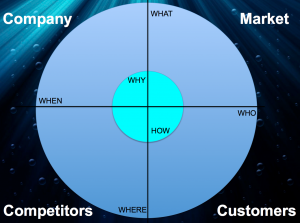2. Barometer. Imagine the following: you make an appointment to see your doctor after several weeks of worsening cold and flu symptoms. The doctor finally enters the exam room and you exchange a few pleasantries. However, she doesn’t ask you any questions or take any tests. She writes a prescription, hands it to you, and leaves. You’d think this was nuts, because in medicine the adage is, “Prescription, without diagnosis, equals malpractice.”
We often commit this mistake in business. We prescribe strategy and initiatives without first diagnosing the business. Good strategic leaders are continually working to understand the context of their business. They are constantly assessing the situation and have adopted the mindset of an insight seeker. A barometer is an instrument designed to measure pressure changes. Without a keen understanding of the changing pressure points in your business, it’s impossible to determine if the actions you’re taking are helping or hurting your cause. Do you have a good feel for the current context of your business? If you don’t know what’s happening around you, there’s a good chance it’s happening to you.
The tool I developed to help managers gauge the changing pressure points in their business is called the Contextual Radar. To create a Contextual Radar, draw a large circle on a piece of paper. Then draw one line from top to bottom and another from side-to-side so you have a cross in the circle. Label the upper right area “Market,” the lower right area “Customers,” the lower left area “Competitors,” and the upper left area “Company.” Next, fill in the four areas with the key happenings or issues occurring in each. The tool provides an excellent means of monitoring the highlights of the business and functions equally well as a way to dialogue on important issues with colleagues. Remember, diagnose the business before prescribing a strategy.
3. Big Picture. One of the biggest gaps I’ve seen in organizations is between the strategic plan in a binder and people’s day-to-day activities. Let’s face it: most people simply don’t use their strategic plans to drive daily activities. And if you’re not using your plan to drive daily activities, you may as well not have one at all.
One way of bridging that gap is to see the big picture. We often hear strategy described as “THE BIG PICTURE,” so why not draw that big picture? We can create a picture of our business on one page by using a tool called the Activity System Map. The Activity System Map identifies our 3-5 strategic themes, the areas where we put most of our resources to create differentiated value for customers and the activities or tactics that support them. First identify the three to five strategic themes, the focal areas for resource allocation that provide differentiated value. Draw large circles to represent these strategic themes. Then attach the tactics supporting these themes with small circles. Review and edit the tactics to ensure your big picture is as clear and compelling as possible.
If multi-millionaire Major League Baseball players invest six weeks to practice the basics, it seems a bit ridiculous that we don’t even take one or two days a year to refresh our business strategy skills. Most businesses spend 100% of their time playing the game and 0% on practicing to get better. Make no mistake, this year you and your team will either get better or worse. And with the #1 cause of bankruptcy being bad strategy, getting worse takes the umpire’s call, “You’re Out!” to a whole new level.
